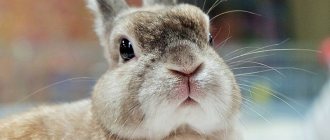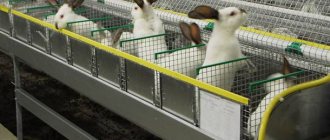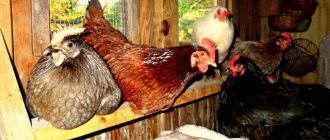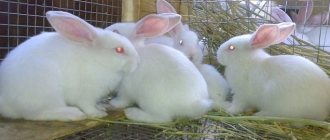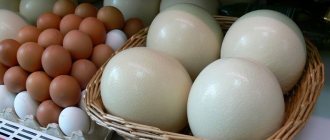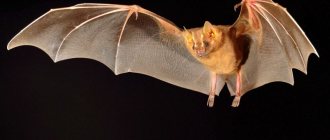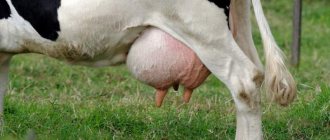Those who are faced with raising rabbits for the first time are sometimes at a loss as to when their decorative pets rest, or rather sleep. If you observe the ears, it may seem that the animals are constantly active. Experienced breeders know that at first glance it only seems so, but in reality the animals manage to rest and sleep even with their eyes open.
Scientists call decorative rabbits twilight animals because they are active in the mornings and evenings, and rest more the rest of the time. Eared animals are characterized by intermittent and restless sleep, which was passed on from their wild relatives. In nature, rabbits sleep for a short time. They need to be careful, because predators could be waiting for them every minute.
In what conditions do rabbits like to sleep?
At home, the predominant time when rabbits sleep is during periods when no one is at home and there are no sounds around that frighten him.
To sleep, young pets choose a sitting or semi-sitting position. This position is most convenient for running away in case of danger.
Over time, when the animal gets used to its living conditions, its position becomes more relaxed. The animal sleeps on its side or on its back, with its pelvic limbs raised up. In the latter case, such a trusting position is a sign that the pet is completely relaxed and feels safe.
For a more comfortable existence in the animal’s cage, you need to arrange something like a mink. To do this, you need a small area where either a special wooden house is installed, or a pile of hay is placed in the most secluded corner. You can also hang a curtain or place a cardboard box there.
This enclosed space creates a feeling of security and ensures a more restful sleep. The cage is placed in a quiet place.
It is worth considering that animals can chew their houses, so they are replaced periodically. The tray, feeders and drinkers are installed at the opposite end of the cage.
Smell
Very often, when purchasing decorative rabbits, future owners are interested in whether there is any smell from the animal. The answer to this question can be unequivocally that young and healthy animals do not smell.
Important! If the animal suddenly starts to stink, it means that it has some kind of health problem or the owner is not taking good care of it.
An unpleasant odor may appear for the following reasons:
- poor quality care;
- puberty;
- inflammation, cystitis, stomach upsets;
- diet;
- age and sex of the animal;
- conditions of detention.
Note! Another reason for the appearance of an unpleasant odor may be a special secretion that males secrete to mark their territory.
How long do rabbits sleep per day?
Do decorative rabbits sleep and what is the daily duration of sleep? On average, the norm for a long-eared animal is to sleep for about 9 hours. However, in the wild, animals cannot afford such luxury, and pets can rarely be found sleeping peacefully.
In the wild, long-eared animals practically cannot afford a relaxed sleep, lying down in a waddle. To do this, you need to feel complete safety, which is extremely rare outside the owner’s home.
This is due to the fact that animals sleep at short intervals. At the same time, their sleep is extremely sensitive. A small noise or rustle causes a timid pet to immediately return to wakefulness. In this case, the animal must quickly begin to navigate its surroundings in order to protect itself from possible danger.
Even in its hole, an animal cannot feel completely safe, because predators are capable of striking at any moment.
In the vast majority of cases, rabbits sleep in a semi-sitting or sitting position. This position of the body allows you to quickly break loose and run away from the source of danger. At the same time, the animal’s eyelids do not droop completely; the rabbit’s eyes seem to be squinted, but not closed. There are even cases where timid poor creatures sleep with their eyes wide open. They simply needed to adapt to such sleep in order to survive.
Throughout the day, young individuals can sleep in short intervals of no longer than 5 minutes. Being in a calm environment, they quickly fall asleep, but despite this, their sleep is very sensitive. During the day, such intervals are repeated often, thanks to which it is possible to gain several hours of sleep in total. At night, spending time in a mink, the animal can afford longer sleep.
Dwarf domestic rabbits follow mostly their instincts, so their sleep schedule and its characteristics are similar to their wild relatives.
How long does sleep last?
The average total time rabbits sleep per day is up to 9 hours. They do not have long periods of sleep like most animals.
Such intervals are repeated, as a result of which several hours of sleep are gained. Getting used to the environment, and sometimes to safe noise, pets begin to sleep longer.
At night, the phases of wakefulness and sleep also replace each other. But sleep time tends to increase if the pet is in calm conditions.
When do they fall asleep?
During the day, rabbits sleep lightly and intermittently; they do not fall into deep sleep. Any extraneous sound, rustle or noise instantly returns the pet to wakefulness. Animals must immediately orient themselves in their surroundings so that in case of possible danger they can react to defend themselves or flee.
At night, in quiet conditions, rabbits sleep for a longer period of time. However, the phases of activity are also preserved, because night is a relatively safe time in the wild. Not all predators are good at navigating in the dark, which gives the rabbit an advantage when chasing. It is in the dark that these animals can calmly move and look for sources of food, etc.
Popular breeds
The Hermelin (Polish rabbit) is a dwarf rabbit, and many other types of mini rabbits have been bred from this breed. Pets of this breed are only white with red or blue eyes. With proper care, the Hermelin's physique is strong and elongated. The weight of the animals ranges from 800-1500 grams, the length of the ears is from 4 to 7 cm, the tail is pressed tightly to the body.
The colored rabbit (dwarf) is a relative of the Polish multi-colored rabbit. The description of the colored dwarf rabbit almost completely coincides with the characteristics of the Hermelin breed, with one exception - the color of the fur. There are various shades: white, red, blue, orange, black and others. Wool of medium length. The colored dwarf rabbit has a friendly character and can become a furry friend for its owner.
Dwarf shorthair sheep got their name because of their unusual appearance: they have huge eyes and a wide forehead. The physique is strong, weight varies between 1.5-2 kg. Rabbits of this breed have a very beautiful back line and long hanging ears, which reach 24-28 cm in length. In the female rabbit they are slightly smaller.
The fox ram has wool with longer hairs than the dwarf ram: it practically touches the ground, since its length ranges from 5-5.5 cm. The hairs of the fox ram do not fall off, making it much easier to care for its fur, which is why this breed has won hugely popular among pet lovers. The pet is fox-colored, hence the name.
The Dutch Fold was bred by scientist Andrian de Kock. Almost no one believed that he would be able to breed a French ram in a mini format, since as the size of the body decreases, the length of the ears correspondingly decreases, that is, they cannot hang. However, after 12 years of hard work, the scientist achieved the desired result and registered the breed in 1964.
Note! Today, Dutch Folds have ears up to 22-27 cm long, but they begin to droop only one to two months after birth.
Features of sleep and vision
Basic physiological characteristics of all breeds:
- animals see well at night and navigate in space not only with the help of their eyes, but also with their whiskers. They manage to detect the slightest vibrations over long distances;
- Decorative rabbits can fall asleep in a split second and wake up even faster. They do not have to lie down to sleep; they can rest while sitting or even standing. If a pet sleeps lying down and with its eyes completely closed in the presence of household members, then this indicates that it completely trusts them;
- Sometimes animals sleep with their eyes open. This allows you to fully analyze the situation around you while you sleep. This feature of the body allows you to quickly wake up and run away from a predator or any other potential danger.
Where do brown hares live?
These are field and steppe animals (for the most part), unlike white hare, which primarily live in the forest. Hares almost always sleep during the day and feed at night. They dig up the snow over winter crops and eat green sprouts. If the hare cannot for some reason (deep snow, ice, frost) get to the winter crops, he resorts to the gardens, where he eats the remaining stalks or unpicked carrots. It also gets close to haystacks, eating dry grass. Willingly feasts on the bark of fruit trees - young apple trees - in gardens. Rusaks thus cause great harm to the national economy - fields, orchards and vegetable gardens. This is why the villagers dislike them.
When do decorative rabbits sleep?
It is quite normal for animals to sleep, both during the day and at night. The little fluffy sleeps on average 5-6 hours a day. But since rabbits are considered nocturnal animals, they prefer to sleep in the morning or afternoon.
An interesting point is that long-eared animals do not close their eyes during sleep, but only squint slightly. This instinct is genetically embedded in them. They are always on their toes and are ready to quickly act (run) if they sense danger. The same can be said about decorative breeds of rabbits.
What to do if your rabbit doesn't sleep at night?
Most likely, your pet will not observe the silence regime, since it is a nocturnal animal. Noise at night is a common occurrence for a pet; he can chew and rustle the contents of the cage. Unfortunately, this will be a problem for light sleepers.
To reduce noise, you can cover the top of the cage with a thick blanket or hang it so that it swings a little when moving. Under no circumstances should you knock on the bars of the cage or shout at the animal, this will only worsen the problem.
Thus, before getting a new pet, it is necessary to take into account the behavior and sleep characteristics of decorative rabbits. Knowing the nature of the animal, which is predominantly nocturnal, you need to first decide whether you can put up with noise at night.
The following will help calm down a noisy little ear:
- Arranging a hole or tunnel where the animal will spend the night.
- Stroking the animal to relieve stress.
If such noise bothers you, you can use the recommendations of experienced rabbit breeders:
- Cover the rabbit's home with a thick cloth at night.
- Place the animal's cage away from the bedrooms.
- Minimize contact and access to the rabbit with other pets.
Tips for owners
Even if you want to know how rabbits sleep, do not interfere with their rest. It is forbidden to guard a rodent or constantly watch it, because the animal will get scared and, in general, will not sleep. Try to create comfortable conditions for the rabbit, provide him with peace and quiet.
In addition, it is necessary to place the cage in a place where the rodent can rest from extraneous sounds. The cage should contain a house in which the animal will hide from prying eyes. Experienced rabbit breeders advise talking to them. After some time, the rodent will get used to your voice and stop being afraid.
Source
Is it possible for a rabbit to sleep in the same bed as a human?
As they say, the owner is a master, but remember that defecation of a rabbit, outside the cage, occurs at any time; the frequency is not regulated as in cats, dogs and other carnivores. In addition, the rabbit has a physiological obligation to eat its night feces, or rather caecotrophs (a type of feces). If this doesn’t bother a person, then why not put the rabbit next to you in bed.
The rabbit, in the wild, is predominantly a nocturnal animal, although we know many examples when nocturnal and crepuscular animals in domestic breeding adapt to the human regime, sleeping when a person sleeps.
To understand in practice whether a person can take a rabbit into his bed, one night is enough
One last thing on this subject, rabbits are not good at jumping from heights. I can say that lop-eared rabbits definitely cannot, since their ears cover part of their eyes, this leads to disorientation in space. Therefore, all the peas will remain in bed.
Where should a rabbit sleep?
A cage with a decorative rabbit should be placed in a quiet place where there is no or minimal movement. No loud noises should be heard nearby. For the safety of your pet, it is necessary to arrange a kind of hole in the cage in which the animal can hide if it senses danger. A closed space creates a feeling of security and will contribute to a more restful sleep.
What are the membranes of the visible part of the eye called?
It is believed that it is impossible to detect changes in eye color in rabbits. Indeed, outbred rabbits' eyes look like buttons and are dark in color. In fact, even in animals with eye pigmentation, pathological changes in the color of the mucous membranes of the conjunctiva, sclera, and third eyelid can be seen.
Photo. The eyes of wild rabbits look like uniformly colored buttons
The examination of the organs of vision is carried out under local illumination, so it is better to separate the different structures of the eye.
Photo. Rabbit eye with markings
- The pupil is in the center of the eye. It has the darkest color
- The iris primarily determines the color of the eyes. Albinos have red, sometimes blue, irises; other breeds of rabbits have brown irises.
- Sclera. In order to see, you need to pull down the lower or upper eyelid. In its normal state, the sclera is pale pink in color, sometimes slightly pigmented.
The nictitating membrane (third eyelid) is not normally visible, hidden in the corner of the eye, closer to the nose
Rabbit who wants to sleep
If your baby can't fall asleep, it's time to go on a sleep quest with Roger Rabbit and his mom! The wizard Uncle Zeva, the wise Sleepy Owl and the very slow Old Snail know how to help you.
This incredibly popular fairy tale all over the world was written by a professional psychologist. She relieves tension and smoothly puts the child to sleep thanks to special techniques based on Erickson's method of hypnosis. Psychologists confirm: the book is completely safe, and the effect of reading depends on the characteristics of the child. Most children fall asleep already in the middle of the story. We hope the book will help your family too.
Today, thousands of parents exhausted by lack of sleep thank the author from all over the world.
Book chips
- The book is based on special psychological techniques that help children fall asleep easier and faster every day.
- Tested by MYTH on my children!
- The book has been translated into 43 languages. 1.6 million copies sold worldwide.
- Initially, Karl-Johan Forssen Erlin published the book in Swedish and English independently, but in the very first months of sales it soared to the top of world rankings and was recognized as a real phenomenon in the world of literature.
- The book is personalized; places where you need to address the child by name are specially marked. This helps children perceive the text better.
About the book series
More than two million copies of the book The Rabbit Who Wants to Sleep and almost the same number of its sequel The Baby Elephant Who Wants to Sleep have been sold worldwide. Currently these books have been translated into 46 languages. Roger Rabbit and Sonya the Elephant have managed to fall in love with Russian little readers, and every day more and more children fall asleep to the lulling sleepy tales. A little later, a tractor named Roger joins their company, the last book in the series at the moment.
All books have a calm and cozy design. Pleasant, slightly rough to the touch cover, sleepy-tinted pages, kind and beautiful illustrations.
Before using these books, in order to achieve the desired sleepy effect, you need to read the instructions. Be careful, dads fall asleep first.
Smart heads
It would be a misconception to think that domestic rabbits are stupid animals. These cunning creatures can easily learn to open the latch on their cage in order to arrange unscheduled walks around the master's house and feast on prohibited pieces of furniture, curtains and wires. In addition, their intelligence allows them to reach such a level of harmfulness as to wake up the owner at night, causing chaos in their home with the sole purpose of begging for some treasured and favorite delicacy.
They are able to show intelligence in extreme situations. There are cases where a domestic rabbit escaped from a dog attack by crawling through a hole in the fence. The dog could not crawl through this gap and was forced to jump over the obstacle. As a result, she was so exhausted that she gave up and went home, leaving the furry sly guy alone.
Bed or hole?
Lying down, especially if the hare is not particularly disturbed, can be repeatedly used by him as a place of temporary shelter. But most often the hare is looking for new places. But in winter, during severe frosts, it digs holes in the snow up to one and a half meters deep, in which it spends most of its time, going outside only in search of food or in case of danger.
It is interesting that the white hare only compacts the snow and does not throw it away. In winter, tundra hares dig holes up to eight meters long, using them as permanent shelters. When danger arises, tundra whites do not leave the den, but hide inside and wait. And in the summer, marmots and arctic foxes use empty dirt passages as shelters. Where do hares live? In holes left by other animals. It is spacious and has enough room for long ears.
What to do if your rabbit has trouble sleeping?
When a twilight animal finds itself in a new environment, it experiences stress and is in constant tension. For this reason, the rabbit has problems sleeping. Anxiety can manifest itself not only in young but also in adults. In order for a herbivore to normalize its sleep pattern and sleep enough hours a day, it is necessary to create a quiet and calm atmosphere for it.
Before getting a furry pet, you need to prepare its habitat in advance:
- After purchasing a cage for an animal, you need to take care of its location. It should be a quiet room without extraneous noise. It is advisable that the radio and television be located away from the rabbit's house. The corridor and other passage areas are not suitable for a pet. Here the rabbit will not feel safe and will not be able to fully rest.
- In the wild, the long-eared animal hides in a hole. He feels safe there. Therefore, you will have to build a small dwelling in the cage where the pet can rest peacefully. It can be made from boards or plastic pipes. This way the rabbit can hide if necessary and feel protected.
- If there are small children in the house, you should explain to them that it is better not to play near a long-eared animal. It is advisable to allocate a place away from the cage for games.
- At night, it is undesirable to make loud noises: turn on music, TV. This very frightens the animal, forcing it to be in constant tension.
- It is not recommended to disrupt the herbivore's regime or disturb it when it is resting or at night. This way the animal will not be able to relax and feel safe.
The animal’s psychological state, healthy sleep and wakefulness depend on the conditions of detention and the degree of care of the owner. Before bringing an eared animal into your home, you need to first prepare a habitat for it and take care of favorable conditions for your pet. If the recommendations are followed, a domesticated rabbit will be able to live peacefully and please its owner.
Source
How and with what to help a rabbit with diseases of the gastrointestinal tract?
A sick rabbit must be given a sufficient amount of liquid (100 ml per 1 kg of weight per day), this will help soften the intestinal contents.
Plain boiled water will do, but it is more effective to use electrolyte drinks designed for humans. Avoid any liquids containing sugar as sugar can increase the number of harmful bacteria in your rabbit's cecum. 2. Force feeding.
A rabbit's refusal to eat can very quickly cause stomach ulcers and liver lipidosis. Already 12 hours without food is a reason to seriously worry. If the veterinarian is confident that there is no complete blockage of the intestines, and if the intestines continue to move slowly, be sure to feed the rabbit.
Hay. Even if your rabbit refuses to eat grass hay such as timothy, oats, etc., it is still best not to give him too much alfalfa hay, especially if he is not used to eating it. A sudden change in diet can provoke an increase in Clostridium bacteria (and alfalfa helps create the most nutritious environment for some strains of bacteria of this species), which can lead to other complications. Therefore, grass hay is always healthier for a sick rabbit than alfalfa hay.
An enema containing warm, clean water and a small amount of an unflavored mineral oil laxative may also be helpful. Adding magnesium sulfate (Epsom salt) to the enema liquid in an amount of 1 tablespoon per 30–40 ml of water helps concentrate fluid from the whole body in the intestines and thereby restore the intestinal water balance. If you decide to use magnesium sulfate, you should make sure that the rabbit receives a sufficient amount of fluid subcutaneously and that its body is not in danger of dehydration.
We prepare our own feed
Today, the specialized market can offer a wide range of these products. And often a breeder simply needs to buy the right product in order to successfully breed rabbits.
Today there are two ways to prepare feed. The first recipe for feed for fattening young cattle has been prepared. And according to the second recipe, a mixture is prepared for females during the period of waiting for birth and for nursing rabbits.
Recipe No. 1
To prepare feed according to this recipe, you will need to stock up on the following ingredients:
- wheat, corn, barley and grain 40% of the total weight;
- herbal flour 40% of the total;
- meat and bone meal, sunflower meal and soy sprat 15% of the total weight;
- yeast, salt and premix 5% of the total mass.
The food is prepared as follows: all components are thoroughly mixed and a little hot water is added to the resulting mass. Everything is thoroughly mixed again to obtain a finished wet wort of a homogeneous mass. Then the resulting mixture is passed through a meat grinder and sent to dry in the oven.
Recipe No. 2
This food will be very useful not only for lactating and pregnant rabbits, but it is recommended to feed the male during the mating period. You can prepare it using the following ingredients:
- wheat and oats 40% of the total weight;
- herbal flour 30% of the total mass;
- cake obtained from sunflower 15% of the total mass;
- yeast and salt 2% of the total mass.
Prepare food consisting of the above ingredients, as in recipe No. 1
In this case, it is worth focusing on another detail. All components, especially cereals, must be finely chopped
Well, if you are making feed for the winter, use more dry grass ground into flour. In the spring version, add freshly cut and slightly dried grass. It should be remembered that the best food for a pet with ears is herbs. Therefore, always put greens in any form in such a product.
